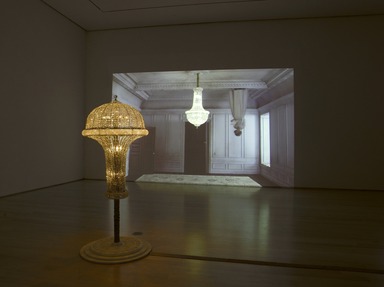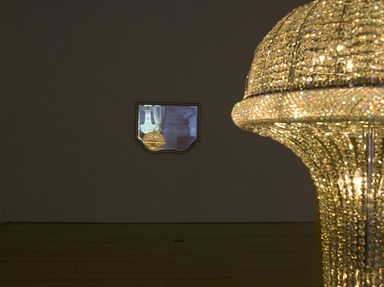
Matthew Buckingham: The Spirit and the Letter
DATES September 03, 2011 through January 08, 2012
ORGANIZING DEPARTMENT
Special Exhibition
COLLECTIONS
Contemporary Art
,
Elizabeth A. Sackler Center for Feminist Art
-
Matthew Buckingham
The Spirit and the Letter
Matthew Buckingham’s installation The Spirit and the Letter draws inspiration from the life and words of Mary Wollstonecraft, the influential eighteenth-century British philosopher and writer on women’s rights. Known for projects that create physical and psychic encounters encouraging viewers to question what is most familiar to them, Buckingham considers the role that collective memory and representations of history play in the construction of identity in contemporary life.
In The Spirit and the Letter, the viewer enters a space where sculptural elements, including a softly glowing crystal chandelier balanced upright on the floor and a framed mirror hanging upside down on the opposite wall, invert physical assumptions to produce an uncanny sense of dislocation. A video projection reflects and reorients this composition within an eighteenth-century public room, where an actress dressed in period clothing recites excerpts from Wollstonecraft’s memoirs and writings. These selections, taken primarily from A Vindication of the Rights of Woman, remain pertinent to contemporary issues of human rights. The artist intends the work and its title to evoke a sense of historical and personal disorientation in which the direct recitation of Wollstonecraft’s observations of two hundred years ago resonates in a modern voice and with a contemporary urgency.
Supporting Buckingham’s project is a small exhibition of prints, documents, and ephemera related to Wollstonecraft’s life and works, including portraits of prominent figures from her intellectual, social, and familial circles. In keeping with the aims of the Herstory Gallery to facilitate exhibitions exploring the histories of women celebrated in The Dinner Party by Judy Chicago, Matthew Buckingham: The Spirit and the Letter engages with notions of historical revision, which is a central goal of Chicago’s iconic feminist work, on view in the adjacent gallery.
Catherine J. Morris
Curator, Elizabeth A. Sackler Center for Feminist Art
-
April 1, 2011
New York artist Matthew Buckingham, whose work examines social memory and historical representation, focuses on the eighteenth-century writer and advocate for women Mary Wollstonecraft in an exhibition to be presented in the Herstory Gallery of the Elizabeth A. Sackler Center for Feminist Art. Matthew Buckingham: The Spirit and the Letter, (2007), a video installation, will be on view from September 3, 2011, through January 8, 2012.
The Herstory Gallery is devoted to the remarkable contributions of the women named in The Dinner Party by Judy Chicago, on permanent view in the adjacent gallery. Mary Wollstonecraft, the pioneering philosopher and writer on women’s rights, is celebrated with one of the thirty-nine place settings in Chicago’s iconic feminist work.
The Spirit and the Letter presents excerpts from Mary Wollstonecraft’s writing, mainly from her important treatise, A Vindication of the Rights of Woman, published in London in 1792, but material is also drawn from a number of her books, letters, memoirs, and tracts, including The Vindication of the Rights of Men (1790). The text, compiled and edited by Buckingham, is spoken as a monologue by an actor in the video component of the installation.
Mary Wollstonecraft, born in London in 1759, is best known for A Vindication of the Rights of Woman, in which she passionately asserted the equality of the sexes and demonstrated through her own intellectual rigor that women are not inferior to men. The essay, the earliest known treatise on the subject, has been viewed as the foundation of the modern women’s rights movements in the Western world. During her brief and unconventional life, Wollstonecraft wrote novels, treatises, a travel narrative, a history of the French Revolution (which she viewed first-hand), and a children’s book. Wollstonecraft died at 38, days after giving birth to a daughter, named Mary in her honor, who would become Mary Shelley, the author of Frankenstein.
Utilizing photography, film, video, audio, writing, and drawing, Matthew Buckingham’s work questions the role that social memory plays in contemporary life and encourages viewers to question what is most familiar to them. His works have investigated matters as disparate as the indigenous past and present in the Hudson River Valley and the inception of the first English dictionary.
Born in Iowa in 1963, Buckingham lives and works in New York City. He has had solo exhibitions at the Museum Moderner Kunst, Vienna; the Dallas Museum of Art; the St. Louis Art Museum; the Lunds Konsthall; the Kunstmuseum St. Gallen; the Hamburger Bahnhof, Berlin; Artpace, San Antonio; the Museum of Contemporary Art, Denver; and the Museo Nacional Centro de Arte Reina Sofía, Madrid.
Matthew Buckingham: The Spirit and the Letter has been organized by Catherine Morris, Curator of the Elizabeth A. Sackler Center for Feminist Art at the Brooklyn Museum.
Matthew Buckingham’s project The Spirit and the Letter was co-commissioned by Film and Video Umbrella and Camden Arts Centre in association with the Des Moines Art Center, Dundee Contemporary Art, FRAC Bourgogne and the Henry Art Gallery with support from the Arts Council of England.
Press Area of Website
View Original

